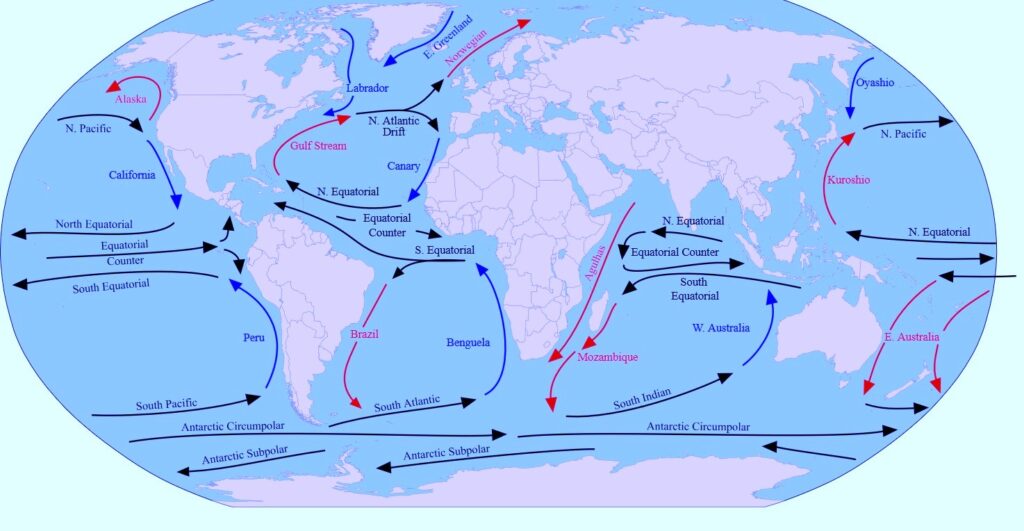
Physical and World Geography MCQs – 01 (Latitudes and Longitudes)
Most important MCQs from the chapter – Latitudes and Longitudes MCQs.
Home » UPSC Study Materials » Prelims Express » Chapterwise MCQs » Physical and World Geography MCQs » World Geography MCQs – 07 (Ocean Currents)
Ocean Currents MCQs with answers and explanations for all examinations.
1. Consider the following statements regarding ocean currents :
1. They move in a definite direction.
2. They can be classified as warm currents and cold currents.
Select the correct answer using the code given below:
(a) 1 only
(b) 2 only
(c) None of the above
(d) All of the above
Correct Answer – (d) All of the above

2. Consider the following statements regarding ocean currents :
1. They are slow surface movements of ocean water
2. Salinity of the ocean water affects them.
Select the correct answer using the code given below:
(a) 1 only
(b) 2 only
(c) None of the above
(d) All of the above
Correct Answer – (b) 2 only
3. Consider the following statements regarding Oceanic Currents?
1. Surface currents are primarily driven by winds whereas deep currents are primarily driven by density difference.
2. Surface currents are swift whereas deep currents are relatively slower.
Which among the above observations is / are correct?
(a) Only 1
(b) Only 2
(c) Both 1 & 2
(d) Neither 1 nor 2
Correct Answer – (c) Both 1 & 2
4. Consider the following statements regarding cold ocean currents :
1. They are usually found on the west coast of the continents in the low and middle latitudes only in the northern hemisphere.
2. The warm currents are usually observed on the east coast of the continents in the low and middle latitudes only in the southern hemisphere.
Select the correct answer using the code given below:
(a) 1 only
(b) 2 only
(c) None of the above
(d) All of the above
Correct Answer – (c) None of the above
5. Which among the following is NOT a factor that influences the direction of the ocean currents?
(a) Wind
(b) Coriolis force
(c) Insolation
(d) Rainfall
Correct Answer – (d) Rainfall
6. Consider the following statements regarding Gulf Stream :
1. It originates in the Gulf of Mexico.
2. It moves in a south-easterly direction.
Select the correct answer using the code given below:
(a) 1 only
(b) 2 only
(c) None of the above
(d) All of the above
Correct Answer – (a) 1 only
7. Which among the following is NOT a cold ocean current ?
(a) Benguela Current
(b) Falkland Current
(c) Labrador Current
(d) Brazil Current
Correct Answer – (d) Brazilian Current
8. Which among the following ocean currents is not found in the Atlantic Ocean ?
(a) Humboldt current
(b) Falkland Current
(c) Labrador Current
(d) Brazil Current
Correct Answer – (a) Humboldt current
9. Consider the following statements :
1. Kuroshio is a cold ocean current.
2. Oyashio is a warm ocean current.
Select the correct answer using the code given below:
(a) 1 only
(b) 2 only
(c) None of the above
(d) All of the above
Correct Answer – (c) None of the above
10. Which of the following areas is/are considered to be the best fishing zone in the world ?
(a) The areas where cold currents flow.
(b) The areas where hot currents flow.
(c) The areas where the warm and cold currents meet.
(d) The area of the sea that is around the equator.
Correct Answer – (c) The areas where the warm and cold currents meet.
11. Consider the following statements :
1. Indian Ocean has the most consistent system of Ocean Currents
2. The Agulhas Current is an Indian Ocean current.
Select the correct answer using the code given below:
(a) 1 only
(b) 2 only
(c) None of the above
(d) All of the above
Correct Answer – (b) 2 only

Most important MCQs from the chapter – Latitudes and Longitudes MCQs.

Most important MCQs from the chapter – Interior of Earth MCQs.

Most important MCQs from the chapter – Types of winds MCQs.

Most important MCQs from the chapter – Atmosphere MCQs.

Most important MCQs from the chapter – The Universe and Solar System MCQs.

Most important MCQs from the chapter – Oceans MCQs.

Most important MCQs from the chapter – Plate Tectonics and Earthquakes MCQs.
We are adding new Notes, Chapterwise MCQs, Quizzes, Previous Years Questions everyday
We are adding new Notes, Chapterwise MCQs, Quizzes, Previous Years Questions everyday